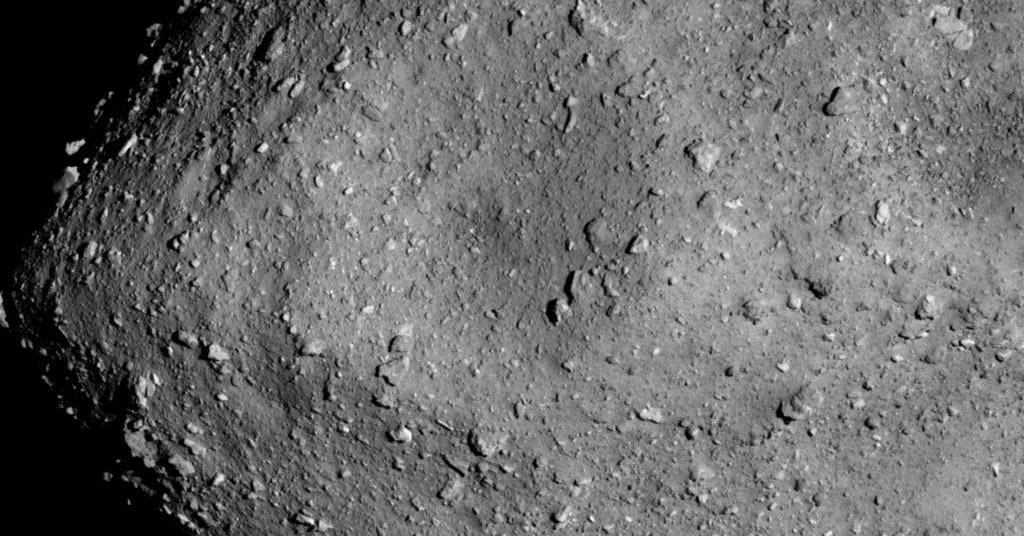
Hayabusa2 also provided the researchers with unique opportunities to observe the asteroid at multiple angles, including hard-to-get images taken at “opposition.” This involved maneuvering the fridge-sized spacecraft to catch snapshots while the asteroid and sun were on opposite sides of it, an alignment that provides views of the asteroid with the sun’s rays reflected directly back toward the camera, without producing any shadows.
Thanks to the physics of optics, anything with a rough surface that reflects light will seem slightly brighter when it’s in opposition. This means that small, faint, and distant asteroids can really only be seen at opposition. In fact, they’re so dark that from Earth we can’t see a “crescent phase,” like the moon has. Domingue and Yokota find that Ryugu is one of the darkest objects ever seen: Reflecting only about 3.5 percent of sunlight, it’s darker than other kinds of asteroids and darker even than a lump of coal.
But taking photos up close and at opposition allowed the researchers to get a detailed image of the asteroid’s surface; it enhanced the way the asteroid’s dust interacts with light, making it clearer that it is in fact there. Bannister says opposition images are like looking at a grassy lawn when the sun is directly behind you, allowing you to see individual blades, as opposed to when sunlight falls obliquely on the lawn, which produces lots of shadows. Comparing opposition images to those taken at near-opposition “tells you how bristly your lawn is, but from a distance, it can all appear completely smooth,” she says.
The mostly shadow-free photos also enabled the researchers to map Ryugu’s surface structure, at least on one side.
This exploration of Ryugu is part of a broader effort to investigate many types of asteroids to learn more about their shapes, contents, and origins. Ryugu is similar to another near-Earth asteroid, called Bennu, that was recently visited by NASA’s OSIRIS-REx spacecraft. They’re both C-type asteroids that are shaped like tops, though with differently accentuated central ridges. The first Hayabusa mission rendezvoused with a more stony, S-type asteroid. NASA’s planned Psyche mission will next year voyage toward an M-type asteroid full of iron and other metals, and the agency’s Lucy craft, which launches this October, will head towards the D-type Trojan asteroids to study the building blocks that formed the Jovian worlds.
The residents of the main asteroid belt, a scattered conglomeration of space rocks Jupiter never allowed to become a planet, have had stable orbits over billions of years, says Andy Rivkin, a planetary astronomer at Johns Hopkins University in Baltimore. In contrast, near-Earth asteroids have wonkier orbits. “Something like Bennu and Ryugu eventually hits a planet or the sun over millions of years, so they can’t have been there very long,” he says.
Ryugu likely formed when something collided with a much larger asteroid, breaking off a bunch of rocky debris that later glommed together and headed on a different trajectory. Meteorites, or chunks of asteroids and comets that hit the Earth, can have similar origins, though C-type meteorites aren’t common, Rivkin says. Upon comparing Ryugu’s structure, terrain, and composition to a variety of other, larger asteroids, Yokota believes that it probably originated from a “parent body” called Eulalia, which is similarly dark and rich in carbon, though other asteroids haven’t been ruled out as its parents.
Research on near-Earth asteroids has implications for scientists’ understanding of bodies that might one day collide with the Earth. “We know of no asteroids that are going to hit the Earth,” Rivkin is quick to point out, but scientists at NASA and elsewhere try to monitor every trackable asteroid, just in case one turns out to be heading in our direction with an arrival time within a couple decades. Occasionally their trajectories can subtly shift, potentially pointing them in a more hazardous direction (from Earthlings’ perspective). This could happen thanks to impacts by smaller objects or to something known as the Yarkovsky effect, which is when sunlight hits an asteroid and gets reradiated as heat, giving it a tiny thrust.


